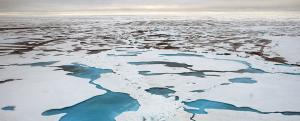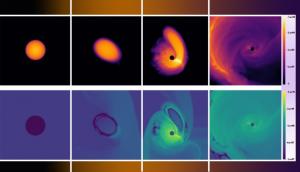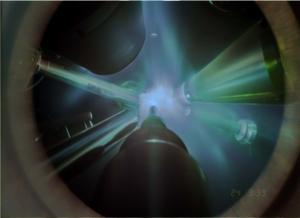LAB REPORT
Science and Technology Making Headlines
Nov. 9, 2018


A new study says the oceans have been taking up more heat in recent decades.
Oceans are in hot water
The world's oceans have been soaking up far more excess heat in recent decades than scientists realized, suggesting that Earth could be set to warm even faster than predicted in the years ahead, according to new research.
Over the past quarter century, the Earth's oceans have retained 60 percent more heat each year than scientists previously had thought, according to a new study by Princeton University. The difference represents an enormous amount of additional energy, originating from the sun and trapped by the Earth's atmosphere -- more than eight times the world's energy.
Paul Durack, a research scientist at the Lawrence Livermore National Laboratory, said the new study offers "a really interesting new insight," but is "quite alarming."
The warming found in the study is "more than twice the rates of long-term warming estimates from the 1960s and '70s to the present," Durack said, adding that if these rates are validated by further studies, "it means the rate of warming and the sensitivity of the Earth's system to greenhouse gases is at the upper end." He said that if scientists have underestimated the amount of heat taken up by the oceans, "it will mean we need to go back to the drawing board" on the aggressiveness of mitigation actions the world needs to take promptly to limit future warming.

Arctic sea ice in September 2017, when the ice reached its annual minimum. In addition, a yellow line marks the 30-year average minimum sea ice extent from 1981 through 2010. Image courtesy of NASA
Nature takes its course
Arctic sea ice loss in the last 37 year is not due to humans alone.
According to new analysis by scientists at Lawrence Livermore National Laboratory, natural climate variability has accelerated Arctic sea ice loss over the last several decades.
Researchers used a variety of climate models and an analytical method known as "fingerprinting" to determine which factors best explain changes in Arctic sea ice. It turns out natural climate fluctuations, including El Niño and La Niña patterns, account for 40 to 50 percent of sea ice loss in the Arctic.
"Internal variability can enhance or mute changes in climate due to greenhouse gas emissions. In this case, internal variability has tended to enhance Arctic sea ice loss," said Stephen Po-Chedley, an LLNL climate scientist,
Over the last decade, Arctic sea ice maximum and minimum extents have routinely set new record lows. The latest research suggests those losses are the result of both human-caused global warming and natural climate variability.


Sierra, one of the fastest supercomputers in the world, will serve the National Nuclear Security Administration’s three nuclear security laboratories. Photo by Randy Wong/LLNL
Supersize it
As supercomputers go, Lawrence Livermore’s Sierra is one of the fastest in the world, ranking at No. 3 on the Top500 list of the speediest computers.
Sierra is hailed as the sister system to the IBM Power 9-based “Summit,” and it replaces the previous LLNL “Sequoia” supercomputer (which only uses CPUs). It will serve the National Nuclear Security Administration’s (NNSA) three nuclear security laboratories, which, in addition to LLNL, include Sandia National Laboratories and Los Alamos National Laboratory.
This computer is approximately 1 million times more powerful than a high-end laptop and built from the ground up (like Summit) for traditional HPC and future AI applications. Its footprint spans 7,000 square feet, and it is made up of 4,320 nodes on 240 computing racks. Each node of the supercomputer includes two CPUs and four GPUs, making Sierra the NNSA’s first large-scale production heterogeneous system. It claims an impressive peak performance of 125 PetaFLOPS, or 125 quadrillion floating-point operations per second.


Supercomputer simulations show the evolution of a dormant white dwarf star reigniting as it whizzes around an intermediate-mass black hole. The top series of images show density, the bottom show temperature.
Raising the cosmic dead
Scientists have found that some black holes could bring dead "zombie" stars back to life — and then destroy them.
Black holes are invisible "objects" in space where the gravity is so strong that it sucks everything into it, even light. All of the black holes that astronomers have found so far are either gigantic — as in hundreds of thousands and even billions of times the mass of our sun — or on the smallish side, as in, say, less than 100 times the mass of our sun. Astronomers haven't spotted any of these matter-sucking beasts in the middle range yet, but that doesn't mean they don't exist.
Scientists at Lawrence Livermore National Laboratory suspect that midsize black holes might be just the right size to provide enough gravitational force to reignite a dead white dwarf star — the stellar corpse of a star that's about the mass of the sun and that's used up its nuclear fuel.
The team ran supercomputer simulations of dozens of different close-encounter scenarios between these dead stars and midsize black holes. Every time a white dwarf got close to the black hole, the star reignited. The gravitational force from the black hole would cause the stellar material to fuse into varying amounts of calcium and iron, producing more fusion and iron as the star got closer to the black hole.


Compression experiments allow liquid water to be driven to an extremely under-cooled state creating a high-pressure form known as ice VII.
New finding ices over
Lawrence Livermore researchers have figured out how a strange form of ice known as ice VII grows at more than 1,000 miles per hour and may lead to a better understanding of “ocean world” planets outside of our solar system.
Liquid water is essential for life, but what happens to it under extreme conditions? “Water on these ocean worlds, under bombardment from other planetary bodies such as meteors or comets, undergoes intense changes for which life might not survive,” lead LLNL scientist Jon Belof said.
“The shock waves launched by the explosions from these planetary impact events can compress water to a pressure over 10,000 times that found on the Earth’s surface and cause the water to freeze into ice VII,” he said. This suggests that these ocean worlds may have a layer of ice VII deep below their liquid water oceans.
“Our aim is to understand as much as possible about the high-pressure phase of water, ice VII, so that we can figure out if these planets really can support life and what the limits of habitability might be,” Belof said.





